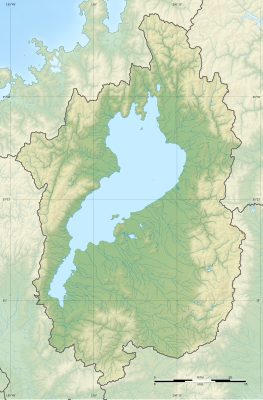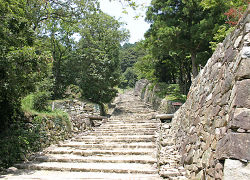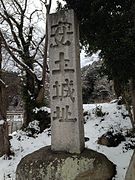Azuchi Castle
| Azuchi Castle | ||
|---|---|---|
|
Azuchi Castle old view |
||
| Creation time : | 1576-1579 | |
| Castle type : | Yamajiro (mountain castle) | |
| Conservation status: | Remains received | |
| Place: | Azuchi | |
| Geographical location | 35 ° 9 '21.7 " N , 136 ° 8' 21.7" E | |
|
|
||
The Azuchi Castle ( Japanese 安 土城 , Azuchi-jō ) was located in Shiga Prefecture on a hill on the edge of Lake Biwa . It was built by Oda Nobunaga as the first modern castle in Japan. After Nobunaga's death in 1582, it was no longer used and fell into disrepair.
history
Oda Nobunaga, the first of the three unifiers, owned various castles, including Gifu Castle . The following reasons can be identified for the construction of another castle on Mount Azuchi: (1) A castle at this point, surrounded on three sides by Lake Biwa, was easy to defend. (2) Lake Biwa could be used as a route to travel on with the Nakasendō and Hokkoku kaidō. (3) A castle there would get in the way of his opponent Uesugi Kenshin . (4) The castle would not be far from Kyoto. (5) With a newly built castle, a new castle town would also arise. (6) A castle there would show Oda Nobunaga's power.
Nobunaga aspired to "heaven" ( 天 , ten ), which also showed his seal. In addition, he had the period of government ( Nengō ) from Genki ( 元 亀 ) on July 28, 1573 to Tenshō ( 天正 ) change. This date is considered to be the beginning of the Azuchi Momoyama Period .
Nobunaga appointed Niwa Nagahide ( 丹羽 長 秀 ; 1535–1585) as commissioner for new buildings ( 普 請 奉行 , fushin bugyō ) at the beginning of 1576 . In February of that year he went there himself, determined the division of the site, ordered building materials and called construction workers together. Since the entire castle area was to be surrounded by stone walls, a large number of blocks were required. The castle was completed in 1579. During the Honnōji incident , the castle was besieged and burned down by Nobunaga's adversary Akechi Mitsuhide in 1582 and then finally abandoned in 1585.
The castle
The castle tower had a basement and seven floors above ground. The stone base was 6 ken (11 m) high , above 16½ ken (30 m). With a height of 46 m, it was the same height as that of the monumental Tōdai-ji temple in Nara . The interior of the castle tower was painted by Kanō Eitoku . In the east the castle districts Hommaru ( 本 丸 ) and Ni-no-maru ( 二 ノ ノ ) joined, in the west the San-no-maru ( 三 ノ 丸 ). Halfway up the way from the Todo Bridge ( 百 々 橋 , Todo-bashi ) to the summit in the southwest was the Sōken-ji ( 摠 見 寺 ) temple , of which only remnants of the foundations have been preserved.
The castle complex reached a height of 100 m from Lake Biwa. The main gate ( 手 門 , ōte-mon ) was located on the south side at the foot of the mountain . While the higher vassals resided on the mountainside, a castle town was laid out in front of the gate for the lower samurai.
Today the castle hill is surrounded by land on all sides. Nothing of the buildings has survived, but you can see the stairs and paths, some of which are lined with walls. Nearby is the Azuchi Castle Prefecture Archaeological Museum . In the amusement park Ise Azuchi-Momoyama Bunkamura ( Mie Prefecture ) there is a replica of the castle tower.
photos
literature
- Nishigaya, Yasuhiro (Ed.): Azuchi-jo . In: Nihon meijo zukan. Rikogaku-sha, 1993. ISBN 4-8445-3017-8 .







